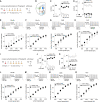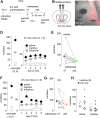Membrane excitability of nucleus accumbens neurons gates the incubation of cocaine craving
- PMID: 37041207
- PMCID: PMC10354025
- DOI: 10.1038/s41386-023-01580-w
Membrane excitability of nucleus accumbens neurons gates the incubation of cocaine craving
Abstract
After drug withdrawal, a key factor triggering relapse is progressively intensified cue-associated drug craving, termed incubation of drug craving. After withdrawal from cocaine self-administration, incubation of cocaine craving develops more reliably in rats compared to mice. This species difference provides an opportunity to determine rat-specific cellular adaptations, which may constitute the critical mechanisms that contribute to incubated cocaine craving in humans. Expression of incubated cocaine seeking is mediated, in part, by cocaine-induced cellular adaptations in medium spiny neurons (MSNs) within the nucleus accumbens (NAc). In rats, decreased membrane excitability in NAc MSNs is a prominent cellular adaptation, which is induced after cocaine self-administration and lasts throughout prolonged drug withdrawal. Here, we show that, similar to rats, mice exhibit decreased membrane excitability of dopamine D1 receptor (D1)-, but not D2 (D2)-, expressing MSNs within the NAc shell (NAcSh) after 1 d withdrawal from cocaine self-administration. However, in contrast to rats, this membrane adaptation does not persist in mice, diminishing after 45-d withdrawal. We also find that restoring the membrane excitability of NAcSh MSNs after cocaine withdrawal decreases cocaine seeking in rats. This suggests that drug-induced membrane adaptations are essential for behavioral expression of incubated cocaine craving. In mice, however, experimentally inducing hypoactivity of D1 NAcSh MSNs after cocaine withdrawal does not alter cocaine seeking, suggesting that MSN hypo-excitability alone is insufficient to increase cocaine seeking. Together, our results demonstrate an overall permissive role of cocaine-induced hypoactivity of NAcSh MSNs in gating increased cocaine seeking after prolonged cocaine withdrawal.
© 2023. The Author(s), under exclusive licence to American College of Neuropsychopharmacology.
Conflict of interest statement
The authors declare no competing interests.
Figures





Similar articles
-
Cascades of Homeostatic Dysregulation Promote Incubation of Cocaine Craving.J Neurosci. 2018 May 2;38(18):4316-4328. doi: 10.1523/JNEUROSCI.3291-17.2018. Epub 2018 Apr 6. J Neurosci. 2018. PMID: 29626166 Free PMC article.
-
Protein Translation in the Nucleus Accumbens Is Dysregulated during Cocaine Withdrawal and Required for Expression of Incubation of Cocaine Craving.J Neurosci. 2018 Mar 14;38(11):2683-2697. doi: 10.1523/JNEUROSCI.2412-17.2018. Epub 2018 Feb 5. J Neurosci. 2018. PMID: 29431650 Free PMC article.
-
GluN3-Containing NMDA Receptors in the Rat Nucleus Accumbens Core Contribute to Incubation of Cocaine Craving.J Neurosci. 2021 Sep 29;41(39):8262-8277. doi: 10.1523/JNEUROSCI.0406-21.2021. Epub 2021 Aug 19. J Neurosci. 2021. PMID: 34413203 Free PMC article.
-
Cocaine-induced projection-specific and cell type-specific adaptations in the nucleus accumbens.Mol Psychiatry. 2022 Jan;27(1):669-686. doi: 10.1038/s41380-021-01112-2. Epub 2021 May 7. Mol Psychiatry. 2022. PMID: 33963288 Free PMC article. Review.
-
Adaptations in AMPA receptor transmission in the nucleus accumbens contributing to incubation of cocaine craving.Neuropharmacology. 2014 Jan;76 Pt B(0 0):287-300. doi: 10.1016/j.neuropharm.2013.04.061. Epub 2013 May 30. Neuropharmacology. 2014. PMID: 23727437 Free PMC article. Review.
Cited by
-
Targeting Neuroplasticity in Substance Use Disorders: Implications for Therapeutics.Annu Rev Pharmacol Toxicol. 2025 Jan;65(1):259-280. doi: 10.1146/annurev-pharmtox-061724-080548. Epub 2024 Dec 17. Annu Rev Pharmacol Toxicol. 2025. PMID: 39374445 Review.
-
Integrative multi-dimensional characterization of striatal projection neuron heterogeneity in adult brain.bioRxiv [Preprint]. 2023 Oct 21:2023.05.04.539488. doi: 10.1101/2023.05.04.539488. bioRxiv. 2023. PMID: 37205475 Free PMC article. Preprint.
-
Molecular and genetic mechanisms of plasticity in addiction.Curr Opin Neurobiol. 2025 Aug;93:103032. doi: 10.1016/j.conb.2025.103032. Epub 2025 Apr 30. Curr Opin Neurobiol. 2025. PMID: 40311544 Review.
-
Fundamental Sex Differences in Cocaine-Induced Plasticity of D1R- and D2R-MSNs in the Mouse Nucleus Accumbens Core.bioRxiv [Preprint]. 2025 Jun 23:2025.06.18.660420. doi: 10.1101/2025.06.18.660420. bioRxiv. 2025. PMID: 40667358 Free PMC article. Preprint.
-
The nucleus accumbens in reward and aversion processing: insights and implications.Front Behav Neurosci. 2024 Aug 9;18:1420028. doi: 10.3389/fnbeh.2024.1420028. eCollection 2024. Front Behav Neurosci. 2024. PMID: 39184934 Free PMC article. Review.
References
-
- Steiner N, Rossetti C, Sakurai T, Yanagisawa M, de Lecea L, Magistretti PJ, et al. Hypocretin/orexin deficiency decreases cocaine abuse liability. Neuropharmacology. 2018;133:395–403. - PubMed
Publication types
MeSH terms
Substances
Grants and funding
LinkOut - more resources
Full Text Sources
Medical
Molecular Biology Databases
Research Materials
Miscellaneous

